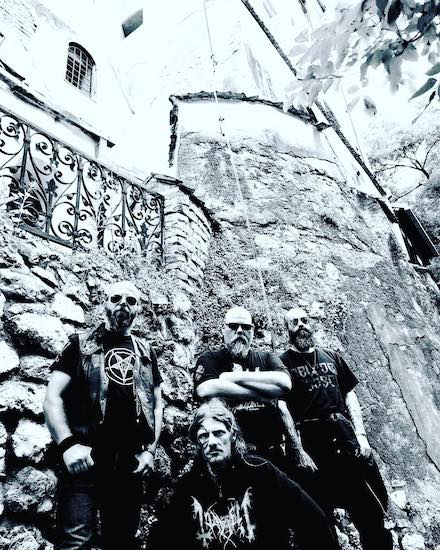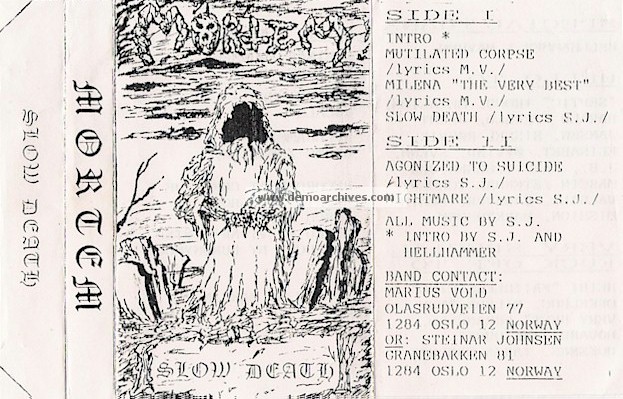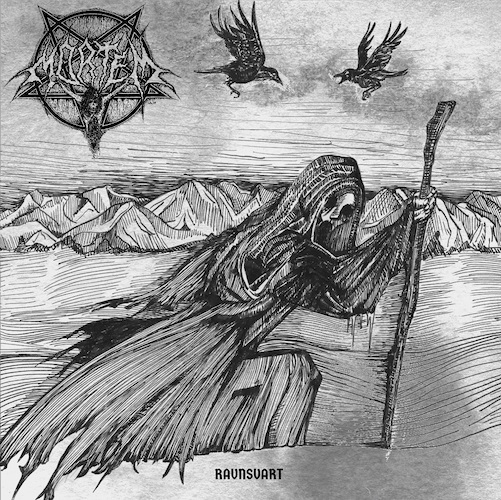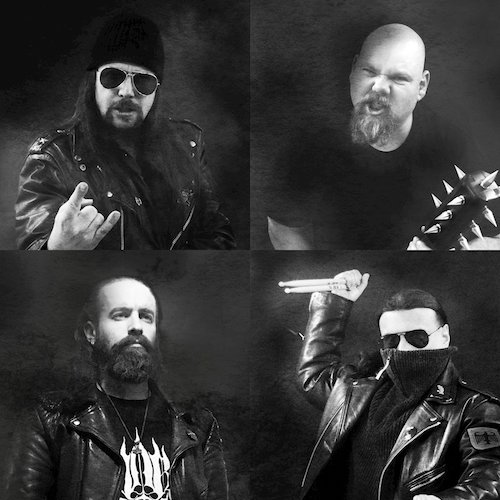(Norway-based NCS contributor Karina Noctum had the chance to interview Steinar Sverd Johnsen, co-founder of the legendary Norwegian black metal band Mortem (as well as Arcturus), about the genesis and the resurrection of Mortem (whose new album Ravnsvart was released by Peaceville this past September) and other related subjects, and we present that discussion below.)
Mortem was formed back in 1989 by Marius Vold (Thorns, Arcturus) and Steinar Sverd Johnsen (Arcturus, Covenant, Satyricon). They released a demo whose artwork was made by Dead (Pelle Ohlin) and had Euronymous (Øystein Aarseth) as its producer. After the demo the artists devoted their time to other endeavors and nothing else was made.
Now they have reunited and produced a skillfully crafted album named Ravnsvart that counts the talents of Hellhammer (Mayhem, Arcturus) and Tor R. Stavenes (1349, Svart Lotus), making it one of the best BM releases this year.
In this interview with Steinar you will find all the information about things past, present, and future of this Black Metal supergroup.
How did Mortem start back in the days?
It was in ’87 when I met Marius at school, and we started playing together, as we had the same taste in music. Mortem was the start of my music career, at age 15 for us. Quickly we decided to make a band together, and we got a rehearsal place.
How did you get Euronymous and Dead to contribute back then?
The music scene for this kind of music was very small at that time, and we contacted Mayhem and Øystein in Ski for friendship, music, and heaps of advice. Those guys were some years older than us, and could help us on the way.
I remember that evening when Øystein come by and introduced their new drummer, Jan Axel. [Hellhammer]. Some days later we met him in Oslo and invited him on an after-party. The day after, we rehearsed with him and we got an agreement with Øystein to keep him ‘Warm’ until Mayhem started to rehearse.
By then we had tracks for a demo ready. We then asked Øystein to help us as a producer, as he had studio experience, and Pelle agreed on making our demo cover. Marchin of Eternal Torment zine did all the typing in the cover. When the demo was released we gave Øystein heaps of flyers that he put in all his letters and spread Worldwide.
What are the lyrical themes all about on the new album?
All but 2 of the songs were written by Marius, who is an amazing writer. They’re very classic black metal but written with a lot more skill than most. Ravnsvart is about the power of nature, the cruelty and force of it, and the darkness it brings with it. Nature is hard, cold, and completely blind. Systematic but also random. It gives life, it takes life. ´kulden kommer med hammerens kraft´ The cold comes with the force of a hammer, which is exactly how it feels here in Norway.
One of the other songs was written by Tor, and was very inspired by the cult horror film Event Horizon and the decaying state of our over-exploited planet, and the last was written by my wife, inspired by a painting by artist Halsey Swain. So there’s a lot of different input, which gives the record an element of diversity.
Tell us more about the meaning of the song “The Core”.
Marius Vold: The Core: In the beginning this song was about Øystein, Euronymous “ruler of the crypt” as it were. Then as it grew it became bigger than Euronymous. It links back to him quite a bit. It’s possible that it is about his somewhat grandiose vision for black metal, which led to this song having so many biblical connotations; “wearing the crown of splintered bones” can be interpreted many ways, A messiah coming, but not who the greater majority expect or want, accompanied by a serpent, the tempting alluring serpent of the garden of eden to lure the stricken herd into this new age. Marius claims this is the easiest to understand; however, like all great creations, it’s the most difficult to explain.
Were there any particular challenges when you tried to regroup the band for a new album?
This started at autumn ’17 when I by coincidence met Marius in a shop after 20 something years, and blah blah bandtalk, and we decided to do some rehearsals with the old tracks. Quickly this escalated to be a new recording and new tracks popped out. It was natural to ask Jan Axel first then for drums to see if we could do the original lineup, and after a few phone calls I got him hooked up and we did a rehearsal, and a rehearsal recording of 3 old and 3 new tracks.
I then played this recording for Tor Stavenes when he was on a visit and he agreed to join on bass. We then added bass on this recording and we got help from the Mayhem Collection to get in contact with Peaceville.
Why didn’t you release something else after the first demo?
After the demo Marius joined Stigma Diabolicum and I started playing keyboards. We were still meeting at the rehearsal place and played music, however the new music I made on the keyboard was so different from the stuff made on guitar that we chose to call it something else, and this is the birth of Arcturus.
Then Marius was done in Mortem and we got in Ken Vamstad on vocals and Krister Jensen (RIP) on bass. Mortem and Arcturus were then running on in parallel universes for a while, and we made, I think it was 7 more tracks. But those were never recorded. Later I found 3 of those old tracks on tapes.
How would you describe Ravnsvart’s sound?
Cold and atmospheric. It’s the combination of the guitars and keyboard sounds that makes it. It was really interesting in the composing process now when I had both guitar, and a keyboard at the other hand, and to join those 2 instruments in the basics of the composition. The keyboard’s job here is to be a second guitar at the same time as just being a keyboard. An example on Ravnsvart are the keys following the guitars and making a way more harmonic sound than just 2 guitars. On other tracks the keyboard is making a good warm carpet under the melody-playing guitar — example, “Blood Horizon”.
What motivated you to resurrect Mortem?
I had a year-long dream of doing some more brutal stuff again, darker, with lots of blastbeats and screaming vocals, and I aired that in Arcturus, but there was no interest of doing such stuff there. A new kinda ‘Aspera Hiems Symfonia album’. So when I met Marius again I used this opportunity to do it as Mortem.
How many concerts have you given since the reunion? How was it like to play live?
By now its one gig in Romania. It was a quite a new experience going on stage as a guitarist this time, especially catching the sound on a big stage when moving around. It was scary as fuck.
How did you prepare to play live? Was it difficult to rehearse enough?
I tried to get several rehearsals before this show to see how it went, but the keyboard-player Adda Mach and Jan Axel didn’t go to rehearsal until 2 days before the show, and that was not enough to deliver a perfect result. Now, with more experience and a totally different instrument setup, I’m really looking forward to the next show.
How did the recording and producing go when it comes to preserving the essence of the old days?
Guess I’m a bit old-fashioned, and that makes it easier to get the old sound. It was also that I chose to use keyboards from the early ’90s — the Ensoniq SD1 is from 1990 — and with this base it was easy to keep the old atmosphere in the production. And Marius has not been in since ’93, and like Tor said when he heard the first recordings, “it sounds like he still is in ’92.”
Who produced the album?
I guess i put my fingers on all parts of the recorded instruments and vocals, to get the right atmosphere, and during the mix it was mostly Børge Finstad who was in charge.
Where did you record it?
The drums on this recording was done in Toproom Studios at Hadeland, asissted by Børge Finstad, then we recorded the guitar and vocals in The Garage in Nannestad. The bass was recorded at my cabin in Nesbyen, Hallingdal as Tor lives at Gol, Then back at Hadeland in Toproom, Børge Finstad did the mix and master.
What influences your musical writing?
It’s mostly Classical music that has the deepest impact on me. With my background as an organ freak from the early ’90s, this has always followed my compositions. Also with a sense of music as theoretical labyrinths and a horrific imagination, the easiest way to get it out is through music.
How long did it take for you to write the album?
Three tracks on Ravnsvart were made in the spring of ’17, before I knew about any Mortem reunion, and the rest of the songs, and the album, were pretty much made in 10 months from February to November of ’18. Marius made 6 of the lyrics in the same timeframe and Hayley wrote “Truly Damned”, and Tor “Port Darkness”. We then recorded the drums in a 3-day period from 04 January ’19, and the mix was done during March.
Tell us about the composition process… What kind of particular consideration do you take now in order to keep the old school sound?
The new thing with this album was the return of the guitar as a composition medium. When creating songs on the guitar I felt like I could do whatever I wanted, since themes on guitar sound quite different from things made on keyboard, and that was a cool experience. It was really interesting in the composing process when I had both guitar and a keyboard at the other hand, and to join those 2 instruments in the basics of the composition. The keyboard’s job here is to be a second guitar at the same time as just being a keyboard. An example on Ravnsvart is the keys following the guitars and making a way more harmonic sound than just 2 guitars. On other tracks the keyboard is making a good warm carpet under the melody-playing guitar — an example is “Blood Horizon”. The old school sound itself is not planned in detail. I guess it sounds a bit old-fashioned because my brain is aging, and I’m not that interested in renewing myself.
What inspires you when it comes to creating the atmosphere in the album?
As mentioned, to make an album like this has been a years-long dream, with heaps of blastbeats and screaming vocals. Lots of the inspiration can be traced to hundreds of hours flying hang gliders over the Norwegian landscape and watching the amazing nature from that perspective.
What are your future plans?
We are planning re-record the demo Slow Death. I’m working on the files for the recording right now, so within a week they should be ready. The demo is quite short and we’ll put in several bonus tracks, both new and others from the early ’90s, all made up with the new Mortem sound.





Awesome interview; thanks for sharing it. The new album is indeed great. Will be interesting to hear the re-recorded demo… Hopefully, Steinar keeps Arcturus going as well.
So hard to find interviews with Steinar! Loved it. What a legend!